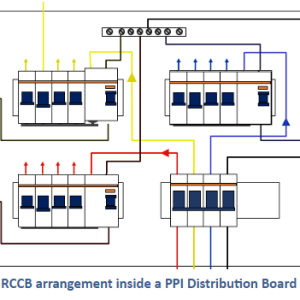While electricity has become an indispensable component of our lives, the fact is, it comes with its own hazards to human life and property. Electrocution and fire being the two major risks associated with electricity, one cannot afford to be negligent when it comes to insulating equipment.
A Residual Current Circuit Breaker (RCCB) is an important safety measure when it comes to protection of electrical circuits. It is a current sensing device, which can automatically measure and disconnect the circuit whenever a fault occurs in the connected circuit or the current exceeds the rated sensitivity.
Why RCCB?
RCCBs are designed to detect the leakage current which prevents from the hazards like electric shock. RCCB can detect the small imbalance current and disconnect the circuit quickly to minimise the risk of electric shock & hazards.
Working Principle
RCCBs operate based on Kirchhoff’s Current Law, which states that the sum of currents entering and leaving a circuit must be zero. They continuously monitor the current flowing through the live and neutral. Under normal conditions, the current entering through the live wire equals to the current returning through the neutral wire. If there’s a difference in incoming and outgoing current it indicates that is leakage of current which is detect by RCCB and rapidly disconnect the circuit within milliseconds to prevent electric shock or fire.
Benefits of RCCB
- Safety against Electrical Shocks & Fire hazards
- Automatically disconnects the circuit when the rated sensitivity is exceeded
- Offers possibility of dual termination both for cable and busbar connections
- Offers protection against voltage fluctuation as it includes a filtering device that guards against transient voltage levels.
- RCCB can be installed in various industrial, residential & commercial applications.
- Early detection of electrical hazards, ensuring a safer environment.
Sensitivity of RCCB
Sensitivity of RCCB can be defined as the amount of leakage current that will trigger the device to trip and disconnect the circuit. For different application there is different sensitivity. Basically there are three sensitivities we prefer 30mA, 100mA, 300mA. In Residential areas generally we use RCCB of sensitivity 30mA. In case of protection from fire due to leakage current we should use RCCB of sensitivity 300mA.
Limitations of RCCB
While RCCBs are highly effective, they have certain limitations:
- RCCB does not guarantee to operate if non-standard waveforms are generated by loads. It’s mainly because RCCB is designed to operate on normal supply waveforms.
- There might be some unwanted tripping of RCCB. It’s mainly because whenever there are sudden changes in electrical load, there can be small current flow to earth especially in the old appliances.
- RCCB does not protect against line-neutral shocks. It’s mainly because current in them is balanced. The current gets balanced as both terminals are held together.
- RCCBs do not protect against overcurrent (overload) or short-circuit conditions.
- RCCBs may trip due to transient currents or voltage surges, leading to nuisance tripping if not properly selected or installed.
RCCB can be classified in various types as mentioned below:
- Type AC: Detects and trips on alternating sinusoidal residual currents.
- Type A: Detects both alternating and pulsating direct residual currents.
- Type B: Suitable for detecting smooth direct residual currents, often used in industrial applications.
- Type F: Designed for applications where both AC and DC residual currents are present, such as in variable speed drives.
- Type H: Offers increased sensitivity for enhanced protection in critical environments.
TYPES OF RCCB:
2-Pole RCCB
- Application: Used in single-phase supply systems, connecting one live and one neutral wire.
- Function: Monitors the current between the live and neutral wires and trips when an imbalance is detected.
4-Pole RCCB
- Application: Designed for three-phase supply systems, connecting three live wires and one neutral wire.
- Function: Monitors the current across all three phases and the neutral, providing comprehensive protection.
Importance RCCB in Power distribution board:
RCCBs are connected parallel to the MCBs inside distribution boards. The neutral connection is done to the neutral links & phase is connected in parallel with MCB as the MCB offers protection against overload and short circuit, and RCCB offers the protection against earth leakage. The neutral is required for the RCCB in order to sense the incoming and outgoing current.
A special kind of distribution board called PPI ‘Per Phase Isolation’ Distribution Board is there in which there is a provision to install RCCB in each phase with separate neutral links provided for each phase such that, the phase which is experiencing a current leakage only that RCCB should trip and other phases can continue to work without any disturbance.

C&S RCCB
Rating from 10 Amp ….100 Amp
Sensitivity 30,100,300 mA
RCCB is therefore extremely important in providing real time protection for circuits. In industries and high voltage commercial set ups especially, its importance cannot be undermined as there is always risk of shocks and accidental deaths on account of it. At C&S Electric, we offer Wintrip RCCB, a state-of-the-art product fit for industrial, residential and commercial application. C&S RCCBs conforms to IEC 61008 – 1 and is used for both control and isolation of electrical circuits. Being a respected global brand for power management products for over 50 years, with C&S Electric you can rest assured knowing that you are in safe hands.
FAQs
A Residual Current Circuit Breaker (RCCB) is an electrical protecting device that protect against the leakage current and prevents electric shock and fire hazards in an electrical circuit. RCCB detect the leakage current and fastly trip the circuit by cutting off the power supply. It is easy to install.
Function:
It detects the difference between the live (phase) and neutral currents. If there’s an imbalance (due to current leakage to earth), it trips the circuit, cutting off the power supply instantly.
RCCBs are used for:
- Protecting human life against electric shocks from direct or indirect contact with live parts.
- Preventing electrical fires caused by earth leakage currents.
- Domestic, commercial, and industrial application.
- 30mA RCCB:
It is best for personal protection because it trips quickly to protect from electric shock. Mostly used in homes and offices. - 100mA RCCB:
It is Less sensitive & suitable for equipment and fire protection. It is used where some level of leakage current is normal.
- RCCB trip because of earth leakage due to faulty wiring or insulation.
- If there is Moisture in appliances or connections.
- Overloaded neutral wires or shared neutrals causing imbalance.
- Incorrect RCCB rating.






